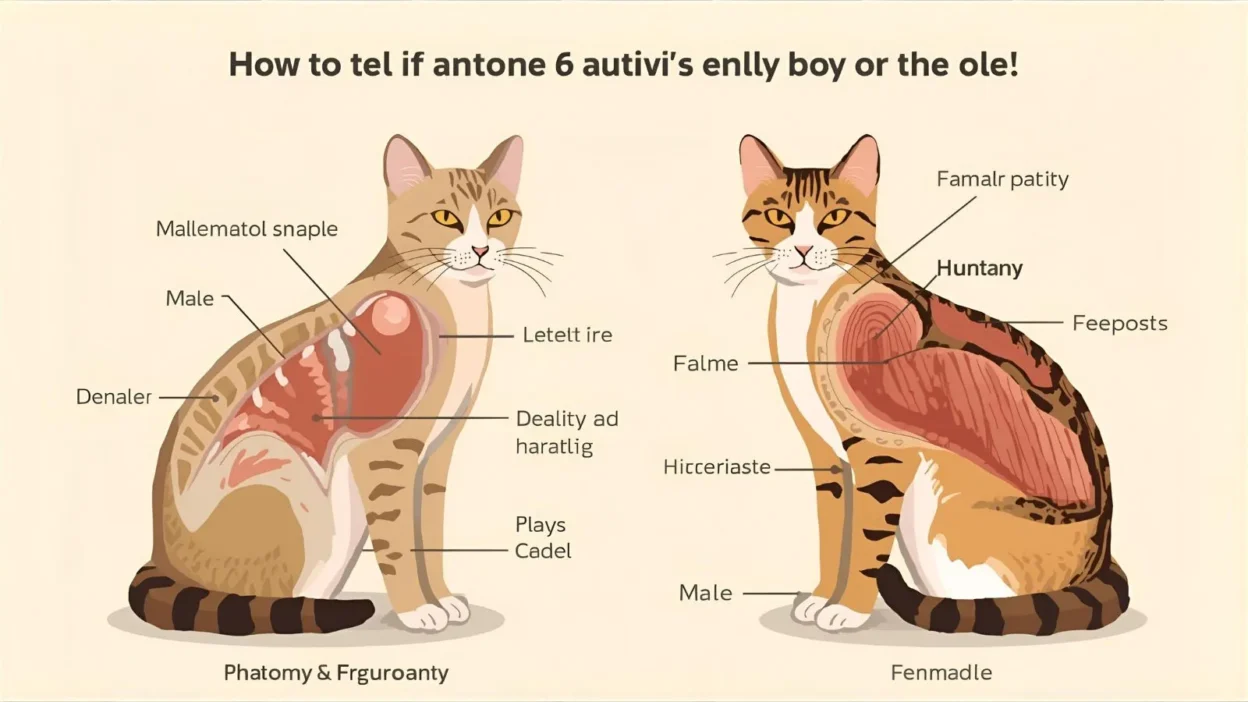Cats are one of the most loved pets around the world, but many new owners face a common challenge: how to tell if a cat is a boy or a girl.
Kittens, in particular, can look very similar at first glance, and this often causes confusion for pet parents.
Knowing your cat’s gender is not just about curiosity—it also helps with proper healthcare, choosing the right name, and understanding certain behaviors.
People usually search this question when they adopt a kitten, rescue a stray, or simply cannot identify their cat’s sex at home.
While veterinarians can confirm it quickly, most pet owners want a simple method they can use themselves.
This article will give you a quick answer, step-by-step tips, common mistakes to avoid, and practical examples so you can confidently identify your cat’s gender.
How to Tell if a Cat Is a Boy or a Girl – Quick Answer
To tell if a cat is male or female, gently lift the tail and look at the area under the anus:
- Male cats: Have a small circular opening (the penis) below the anus, separated by about 1 inch of space. In grown males, the testicles are visible as two small bulges.
- Female cats: Have a vertical slit-like opening (the vulva) right below the anus, with little to no gap between them.
👉 Example: If you see two distinct round openings with a noticeable gap, it’s likely a boy. If you see a vertical slit close to the anus, it’s a girl.
The Origin of “How to Tell if a Cat Is a Boy or a Girl”
People have been keeping cats as companions for thousands of years, but the question of sex identification has always puzzled new owners. The phrase “how to tell if a cat is a boy or a girl” became common in the English language because it is simple, direct, and reflects the everyday need of pet parents.
In older veterinary texts, you may find terms like “sexing cats” or “determining cat gender”, but modern pet owners use plain phrases when searching online. That is why this keyword has gained popularity in search engines.
British English vs American English Spelling
While the phrase itself does not change much across English dialects, small differences in spelling and phrasing appear in articles and pet guides:
| British English | American English | Example Sentence |
| “kitten’s sex” | “kitten’s gender” | “How do I check my kitten’s sex?” vs. “How do I check my kitten’s gender?” |
| “neutering” | “spaying/neutering” | “Neutering is advised at 6 months” vs. “Spaying or neutering is advised at 6 months.” |
| “colour” | “color” | “Male cats often have colour patterns like ginger.” vs. “Male cats often have color patterns like ginger.” |
Which Spelling Should You Use?
- If you are in the US → Use “gender” and American spellings like “color.”
- If you are in the UK or Commonwealth → Use “sex” and British spellings like “colour.”
- For global audiences (blogs, websites, social media) → Use the most common form: “how to tell if a cat is a boy or a girl.” It is simple, clear, and universally understood.
Common Mistakes with “How to Tell if a Cat Is a Boy or a Girl”
- Assuming by behavior alone → Some think only male cats spray or fight, but females can also show these behaviors.
- Judging by size → Males are often bigger, but not always.
- Confusing coat color rules → While calico and tortoiseshell cats are almost always female, this is not a guaranteed method.
- Checking too early → In very young kittens, genitals are underdeveloped and harder to identify.
How to Tell if a Cat Is a Boy or a Girl in Everyday Examples
- Emails: “I just adopted a kitten, but I can’t tell if it’s a boy or a girl. Can you check?”
- News: “Animal shelter workers explained how to tell if a cat is a boy or a girl during adoption day.”
- Social Media: “Help! Does anyone know how to tell if a cat is a boy or a girl? My kitten is only 6 weeks old.”
- Formal Writing: “Sex determination in felines is important for population control and proper veterinary care.”
How to Tell if a Cat Is a Boy or a Girl – Google Trends & Usage Data
- United States & Canada → High search volume, especially during kitten season (spring and summer).
- United Kingdom & Australia → Moderate searches, often phrased as “sexing kittens.”
- Asia & Africa → Growing interest due to rising pet ownership.
| Country | Popular Term | Interest Level |
| US | “cat gender” | High |
| UK | “sexing cats” | Medium |
| Canada | “how to tell if a cat is a boy or a girl” | High |
| India | “male or female cat” | Growing |
| Australia | “kitten sexing” | Medium |
FAQs
Q1. At what age can you tell a kitten’s gender?
Around 6–8 weeks, but more accurate after 12 weeks.
Q2. Can coat color help in sexing a cat?
Yes, calico and tortoiseshell are usually female, while orange tabbies are often male—but exceptions exist.
Q3. Do male and female cats behave differently?
Males may roam more, females may be more nurturing, but behavior varies by personality.
Q4. Is it safe to check a kitten’s gender at home?
Yes, if you handle gently. If unsure, ask a vet.
Q5. Can neutering/spaying affect identification?
Yes, after surgery, testicles may not be visible, but the spacing still shows gender.
Q6. Why is it important to know my cat’s sex?
For health care, neutering, preventing unwanted litters, and understanding behavior.
Q7. Do vets ever misidentify cat gender?
Rarely, but in very young kittens, mistakes can happen.
Conclusion
Learning how to tell if a cat is a boy or a girl may seem tricky at first, but with the right knowledge, it becomes easy. The simplest way is to lift the tail and look at the genital openings: males show two round openings with a gap, while females show a vertical slit close to the anus. While behavior and coat color can give hints, they are not always reliable.
Understanding your cat’s gender helps with healthcare decisions, proper naming, and responsible pet ownership. Whether you live in the US, UK, or anywhere else, the methods remain the same—only the spelling and phrasing differ. By avoiding common mistakes and using practical tips, you can confidently determine your cat’s sex at home.




